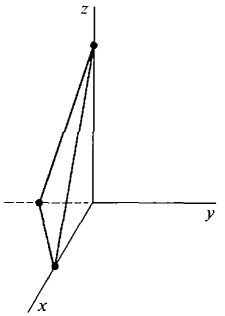| The ebook Elementary Calculus is based on material originally written by H.J. Keisler. For more information please read the copyright pages. |

|

Home  Partial Differentiation Partial Differentiation  Maxima and Minima Maxima and Minima  Examples Examples  Example 5: Closest Distance Example 5: Closest Distance |
|||||||






|
|||||||
Example 5: Closest Distance
Find the point on the plane 4x - 6y + 2z = 7 which is nearest to the origin.
CONCLUSION We know from geometry that there is a point on the plane which is closest to the origin (the point where a perpendicular line from the origin meets the plane). Therefore w has a minimum and it must be at the critical point x = ½, y = -¾ The value of z at this point is z = ½(7 - 4x + 6y) = ¼ The answer is (½, -¾ , ¼). The plane is shown in Figure 11.7.10.
Figure 11.7.10
|
|||||||
Home  Partial Differentiation Partial Differentiation  Maxima and Minima Maxima and Minima  Examples Examples  Example 5: Closest Distance Example 5: Closest Distance |
|||||||
Last Update: 2006-11-15


 . It is easier work with the square of the distance, which has a minimum at the same poi that the distance does. So we wish to find the minimum of
. It is easier work with the square of the distance, which has a minimum at the same poi that the distance does. So we wish to find the minimum of = 2x + 2·¼(-4)(7 - 4x + 6)-) = - 14 + 10x - 12y.
= 2x + 2·¼(-4)(7 - 4x + 6)-) = - 14 + 10x - 12y. = 2y + 2 · ¼ · 6(7 - 4x + 6y) = 21 - 12x + 20y.
= 2y + 2 · ¼ · 6(7 - 4x + 6y) = 21 - 12x + 20y.